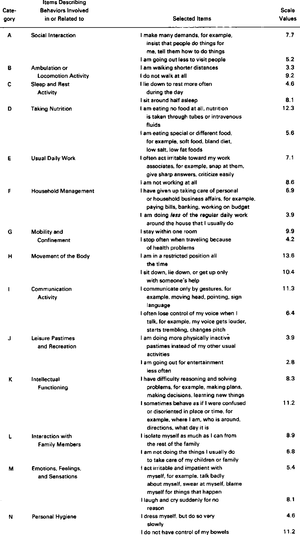Sickness Impact Profile (SIP)
Original Editor - Tolulope Adeniji
Top Contributors - Tolulope Adeniji, Kim Jackson and Uchechukwu Chukwuemeka
Objective[edit | edit source]
The Sickness Impact Profile(SIP), a behaviorally based measure of health status, is used to evaluate a person with disease perceived health status. And it is sensitive enough to monitor changes in health status over time or between groups[1]. SIP measures health status, a patient dysfunction through his everyday behaviour, in relation to his diseases condition. Also, it is used to evaluate effect of diseases on physical and emotional functioning. SIP aids in evaluating outcome of an health care services that can be used for a program evaluation, planning and policy formulation[1][2].
Intended Population[edit | edit source]
SIP is a generic measure questionnaires that can used to evaluate a wide range of conditions and populations[3]. This paper will elucidates on its usage and psychometric properties among the older adults population.
Method of Use[edit | edit source]
SIP is a paper and pencil generic based designed questionnaire to evaluate broad measure of health status, which evaluates a test taker health status based on their responses to the items on the questionnaire. The time to complete the SIP test ranges from 20 to 30 minutes[4] and the major domain on this tool are physical and psychosocial domain. It has 12 categories including sleep and rest, eating, work, home management, recreation and pastimes, ambulation, mobility, body care and movement, social interaction, alertness behavior, emotional behavior, and communication[5]. The tool has 136 items with yes or no response from test taker, see Figure 1.
Evidence[edit | edit source]
Reliability[edit | edit source]
Validity[edit | edit source]
Responsiveness[edit | edit source]
Miscellaneous[edit | edit source]
Links[edit | edit source]
References[edit | edit source]
- ↑ 1.0 1.1 Bergner M, Bobbitt RA, Carter WB, Gilson BS. The Sickness Impact Profile: development and final revision of a health status measure. Medical care. 1981 Aug 1:787-805.
- ↑ Prcic A, Aganovic D, Hadziosmanovic O. Sickness Impact Profile (SIP) Score, a good alternative instrument for measuring quality of life in patients with ileal urinary diversions. Acta Informatica Medica. 2013;21(3):160.
- ↑ Smelser NJ, Baltes PB, editors. International encyclopedia of the social & behavioral sciences. Amsterdam: Elsevier; 2001 Nov 1.
- ↑ Clarke AE, Panopalis P. 4 Quality of Life and Economic Aspects. Systemic Lupus Erythematosus E-Book: A Companion to Rheumatology. 2007 Jan 1:32.
- ↑ Thornton DR, Argoff CE. PSYCHOLOGICAL CONSTRUCTS AND TREATMENT INTERVENTIONS. Pain Management Secrets E-Book. 2009 Jul 31:328.







